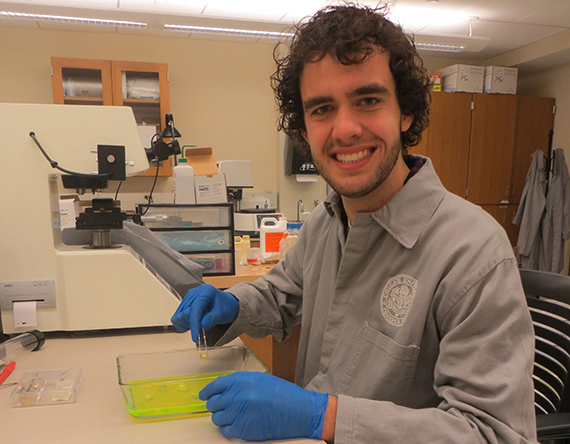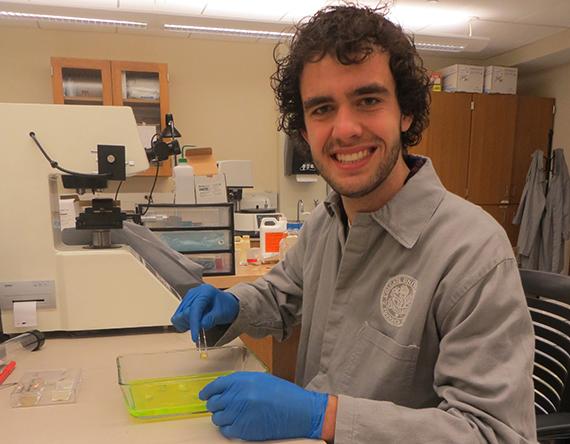
This summer, Brett Christensen ’16 has been raising barnacles at various life stages for a biomineralization experiment.
Colgate students are sharing their experiences conducting research with faculty members on campus and in the field. This post is by Brett Christensen ’16, a biophysics and philosophy double major from Marilla, N.Y.
This summer, I’m studying barnacles — impressive little organisms that live in the ocean. As a biophysics and philosophy double major, I found an opportunity in the research lab of Professor Rebecca Metzler in the Department of Physics and Astronomy.
I was drawn to Professor Metzler’s lab because she focuses on biomineralization, the process by which living organisms use minerals that often make up rocks. This is a salient biophysics topic because even humans biomineralize to form bones, and this process is not well understood.
My research project was formulated by Professor Metzler and specifically explores the intake of calcium by the barnacle species B. amphitrite.
Barnacles begin life as larvae that are free to swim around, but eventually settle permanently in a suitable environment and form a protective exoskeleton. We know that calcium carbonate constitutes a significant amount of the barnacle’s outer shell. But we don’t know when this mineralization process begins or what form the calcium carbonate takes — calcite, aragonite, or amorphous calcium carbonate.
To study this, I raise barnacles at various life stages in a salt-water environment containing calcein, a fluorescent stain that binds to calcium. As individual organisms incorporate calcium into their exoskeleton, they incorporate the calcein along with it.
Then, I image the organisms under fluorescent lighting, and those that have calcein (and therefore also calcium) fluoresce green. So far, my results indicate that calcium first begins to be incorporated into the shell within the first 96 hours after the larval organism has settled, although more work needs to be done to determine a more specific time at which this occurs.
The findings of this experiment will add to our ever-increasing knowledge about biomineralization processes and may even provide insight into how similar processes take place in humans.
This was my first time conducting real research, and it has been a fruitful experience. Professor Metzler is admirably knowledgeable and very patient. Other students working with me in her lab are Nick Knoke ’16, who is studying shell hardness and composition of the barnacle B. ebernius; Rebecca Rist ’16, who is studying cement hardness and composition in the oyster species C. virginica; and Stephanie Warnken ’16, who is studying shell hardness in African gastropods.
This summer, I’ve learned to use various standardized apparatuses, including a scanning electron microscope and confocal microscope. I’ve also discovered how difficult it is to raise and study live organisms, which I found could die in a water salinity or temperature not suitable to their growth. Lastly, I’ve gained a better understanding of how research is done, and I am considering pursuing a career as a researcher.
